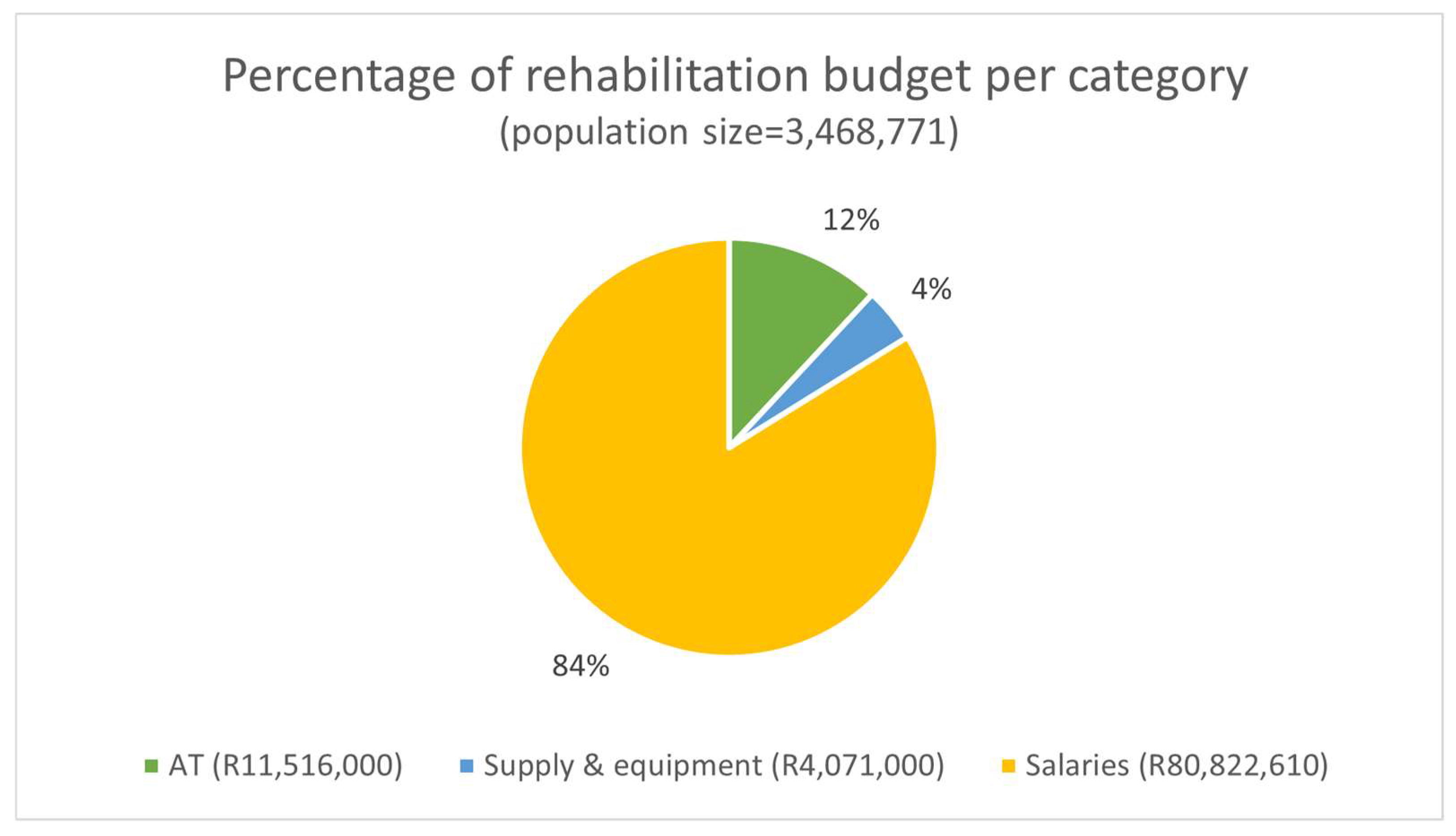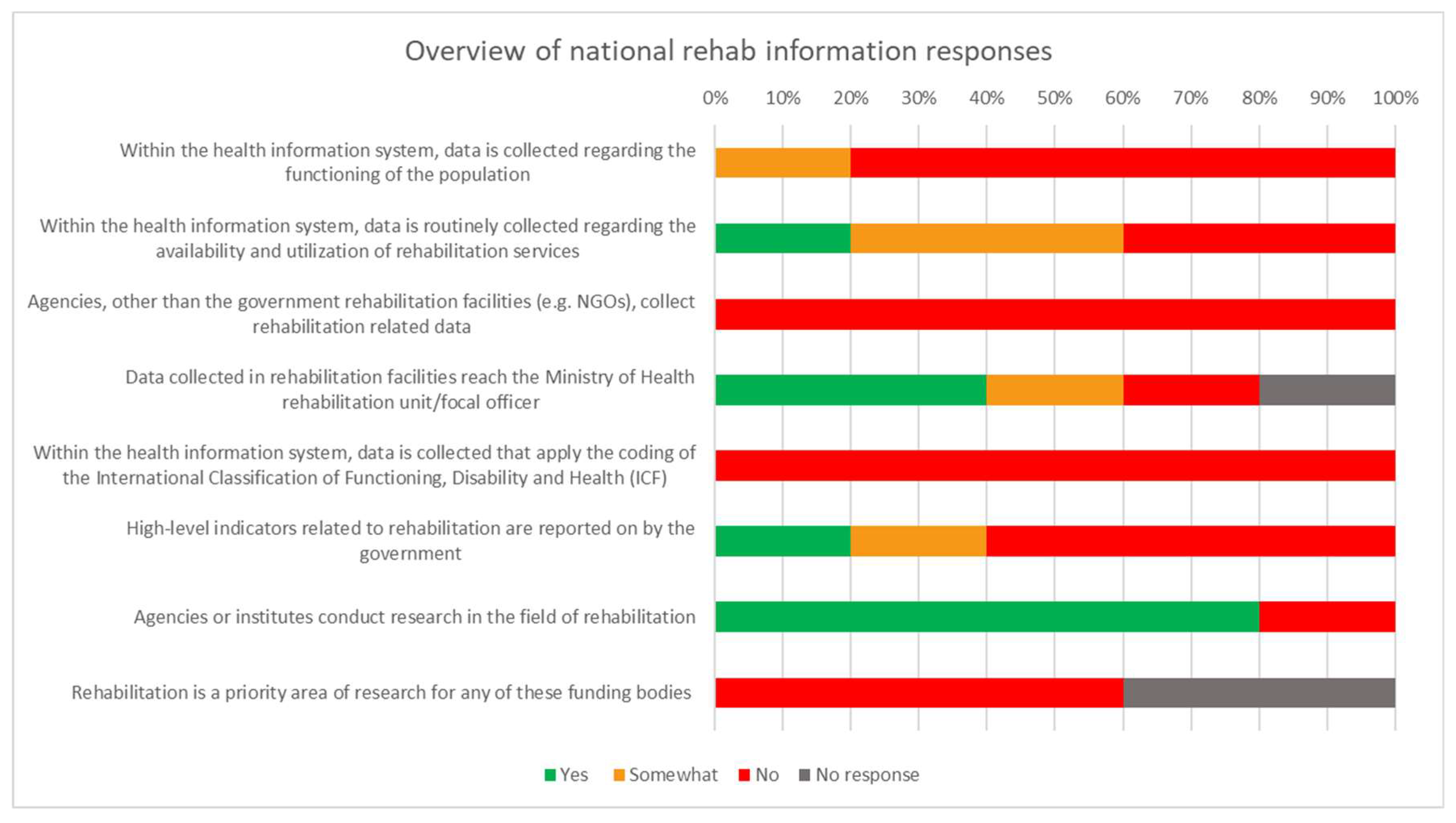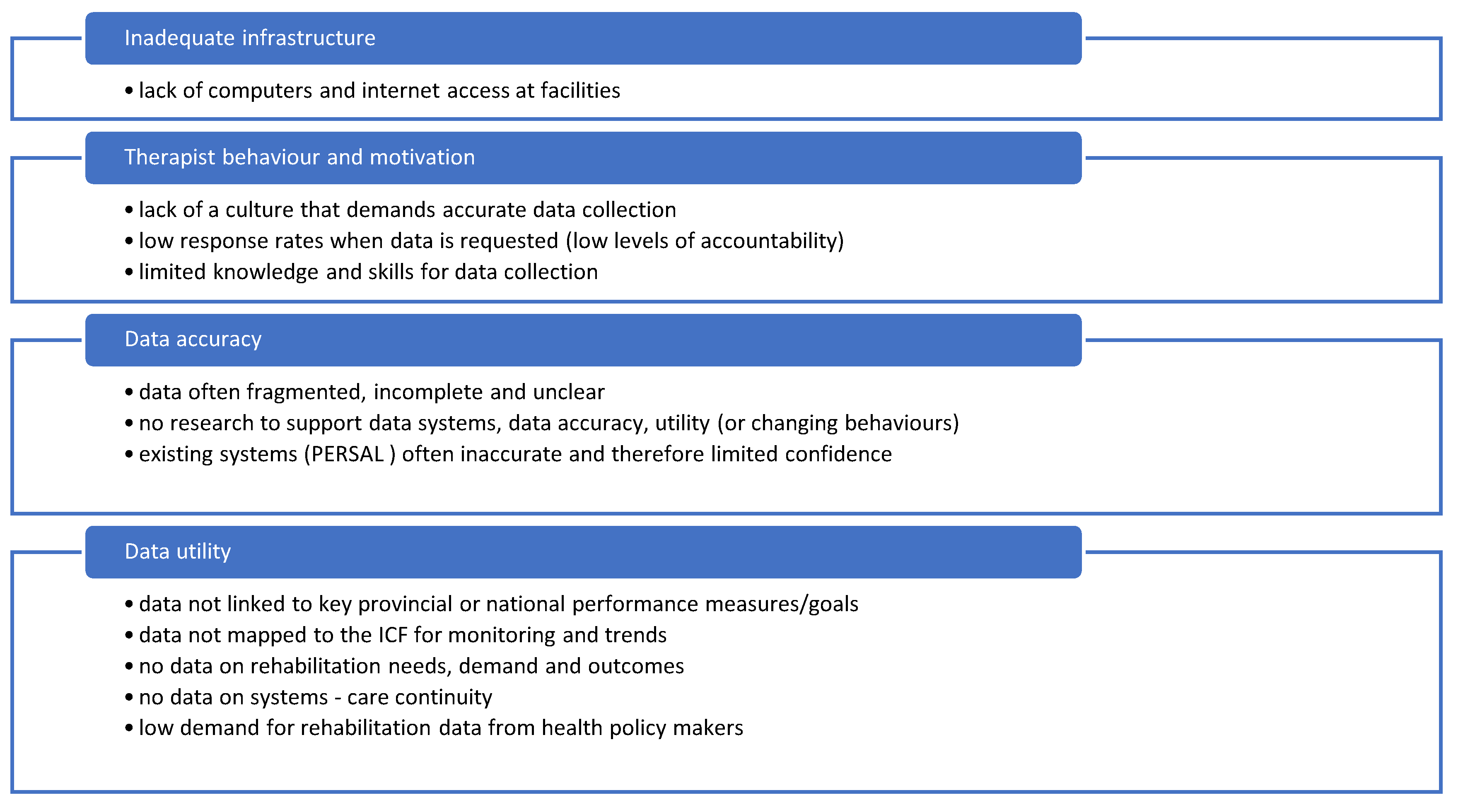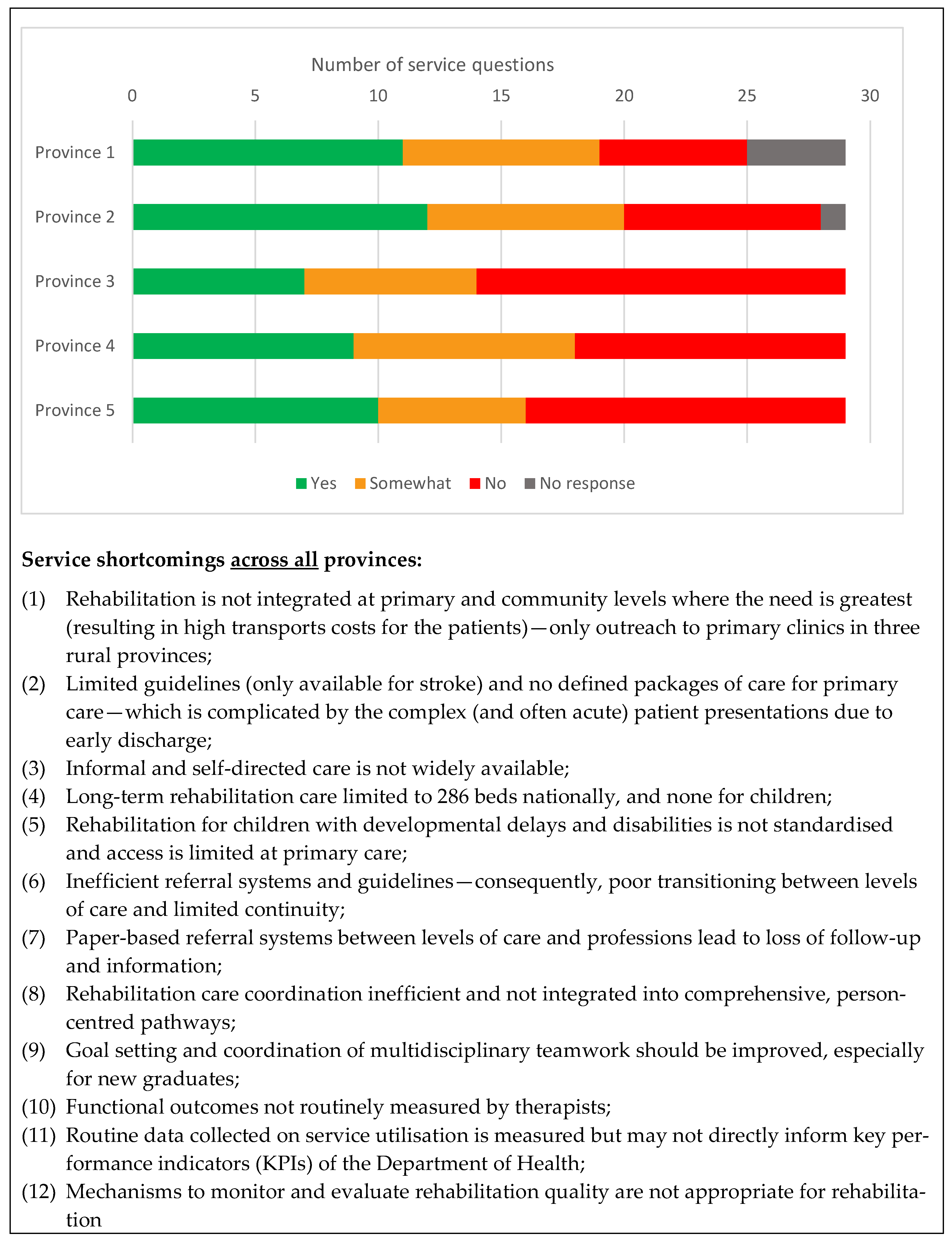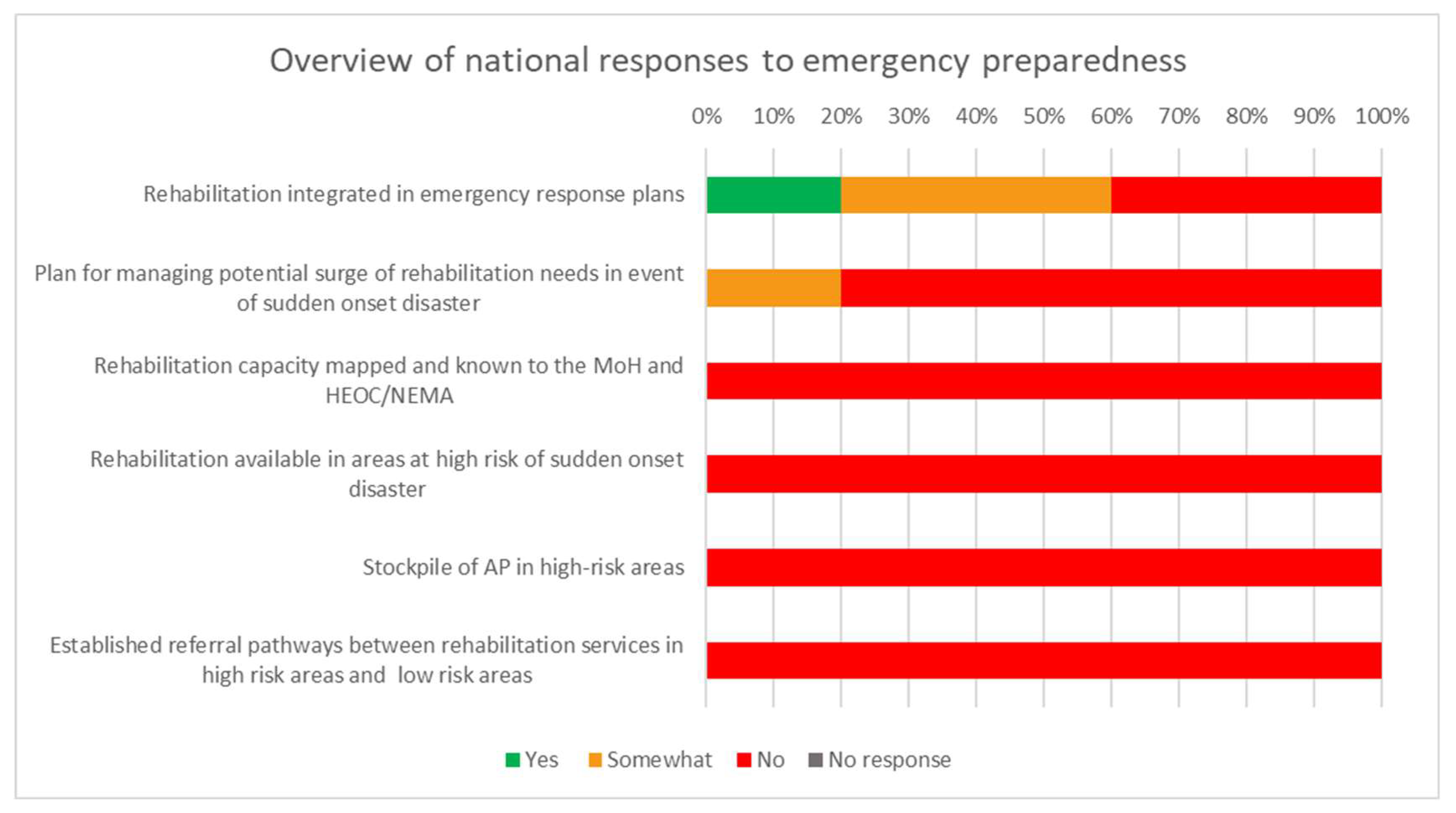1. Introduction
Rehabilitation: Rehabilitation is an essential health service that improves the lives of people with a wide range of health conditions—including many people with disabilities—through optimising their day-to-day functioning. Rehabilitation outcomes may include improved mobility, personal care capacity, the ability to communicate, greater independence, as well as joining (or re-joining) the workforce or attending school or university. Rehabilitation is relevant for people of all ages—for instance, premature infants with developmental delay; children with neurological disorders, hearing, or vision loss; or people of any age recovering from illness, trauma, communicable diseases (e.g., tuberculosis [TB], HIV, COVID-19), or dealing with the sequelae of chronic diseases (e.g., stroke, arthritis, diabetes, heart problems, mental health disorders). People with compromised capacity are often unable to study or work, and hence cannot contribute optimally to their families, communities, or the country. Therefore, rehabilitation, more than the medical management of impairments, incorporates a holistic, person-centred approach to enable optimal reintegration (including social and economic) of people with disabilities and impaired functioning into their communities [
1].
Overview of South Africa’s health challenges: There are many reasons why health status is compromised for many South Africans, and why so many cannot access the care they need. Firstly, the quadruple burden of disease, coupled with less-than-desirable social determinants of health [
2,
3] consistently ensures that many people cannot escape the never-ending cycle of poor health, disability, unemployment, lack of education, and poverty [
4,
5,
6]. Secondly, non-communicable chronic diseases (NCDs) are rampant and largely unmanaged, with life-changing events such as stroke, diabetes, and heart disease affecting many [
7,
8]. Thirdly, the national burden of chronic diseases has increased dramatically since prevalent diseases like HIV (classified as an acute communicable disease five years ago), have recently been reclassified as chronic [
9,
10,
11]. Fourth, the already huge national burden of acute and chronic disease is inflated by consistently high rates of trauma due to violent crimes, motor vehicle accidents, and workplace injuries for casual, unskilled, and uninsured workers [
8,
12,
13]. Fifth, South Africa’s health profile is insidiously compromised by ongoing inequalities based on race, gender, socio-economic status, geographical area (e.g., rural/peri-urban/urban)—remnants of the Apartheid regime—and thus ongoing divides in the quality of (and access to) education and health resources for different population groups. Sixth, post-Apartheid governance continues to experience poor management, particularly affecting major portfolios of health, employment, and education [
14]. There appears to be no imminent resolution for this situation. Finally, the alarming inequity between private and public sector healthcare continues, where those who can afford private care can access some of the best care in the world; while those who cannot, may wait weeks to access basic, and often inadequate, care. The public sector receives just under 50% of the total national healthcare funding (which includes state funding, health insurance, and out-of-pocket payments), but it serves the needs of over 80% of the population who rely on it for all their needs [
15]. These constraints all challenge innovation and improvement in South African health services delivery.
South Africa’s health reforms: Since the first South African democratic election in 1997 (which marked the end of the Apartheid era), the government has embarked on variably successful health reforms, such as primary care re-engineering, to improve access to, and quality of, public healthcare for all South Africans [
16,
17]. However, rehabilitation has not been included in major reforms to date, despite the increasing need for rehabilitation due to the epidemiological transitioning from acute infectious diseases to chronic diseases and NCDs [
17,
18]. South Africa is on the cusp of another major health transformation that has the potential to redress many inequities—namely the National Health Insurance (NHI) [
19], which is intended to provide a health safety-net for the most vulnerable in society. It is thus critical and timely to generate evidence on the current rehabilitation situation, to better describe and understand the shortcomings, opportunities, and priority strategic actions required for rehabilitation to become sufficiently integrated and capacitated within the envisaged NHI. Evidence of national rehabilitation capacity can inform, and reform, policies according to the growing population need for rehabilitation [
18,
20].
Rehabilitation management: In South Africa, policy and regulatory governance of rehabilitation falls within the remit of the National Department of Health (NDoH), but policy implementation and operational management is decentralised to provincial levels. A National Rehabilitation Policy was published in 2000, with strategic goals such as improving access to rehabilitation, appropriate resource allocation, human resource development, and the better integration of rehabilitation and rehabilitation-specific monitoring and evaluation frameworks [
21]. Published reports suggest that little progress has been made towards achieving any goal [
22]. Moreover, this policy has not been updated in the past 22 years. To clarify actions to assist with implementing the National Rehabilitation Policy goals, a Framework and Strategy for Rehabilitation and Disability was developed in 2016 [
18]. To date, there is limited reporting or information from the nine South African provinces about what progress has been made in the National Policy goals. Furthermore, a study conducted by the Human Science Research Council in 2013 suggests that the public sector is not providing effective, efficient, or equitable rehabilitation services [
23]. Because so many South Africans rely solely on the public sector for care, it is crucial to understand the current state of rehabilitation at all levels (national, provincial, district, and community) in order to ensure appropriate actions to integrate rehabilitation within NHI [
24].
Vertical information dissemination: There are nine provinces in South Africa, with very different geography, resources, urbanisation, economics, and social dynamics. Each province has at least one dedicated rehabilitation manager, situated in the provincial health management structure, usually at a sub-directorate level in a larger departmental cluster, for example, Non-Communicable Disease Units (NCDUs). Provincial rehabilitation managers’ mandates involve managing rehabilitation at sub-national level; thus, they are the conduits between policy and action. However, the power of rehabilitation managers to make a difference to rehabilitation capacity is significantly affected by broader systemic challenges, such as fiscal and workforce constraints [
12,
17]. Poor financial management, low levels of provincial and national economic growth over the past decade, and the cross-sector impact of the recent COVID-19 pandemic indicate that rehabilitation may slip further down the list of priorities by policy makers, unless there is committed, unified action to change this trajectory.
Global rehabilitation recognition: The lack of rehabilitation services, and access to rehabilitation in South Africa, is not dissimilar to that found in other low- and middle-income countries (LMICs). The World Health Organisation (WHO) launched the global Rehabilitation 2030 Initiative, which aims to promote rehabilitation as the key health strategy of the 21st century around the world [
25]. This assists countries to strengthen rehabilitation through multipronged approaches, including an assessment process which culminates in strategic planning as well as rehabilitation-specific monitoring and evaluation frameworks [
26]. This approach recognises the specific challenges faced by LMICs, which often have higher burdens of disease and higher needs for rehabilitation, but must prioritise limited resources across different levels and type of healthcare [
19]. The WHO has developed a comprehensive health system assessment tool, the Systematic Assessment of Rehabilitation Situation (STARS), which assists countries to interrogate the state of local rehabilitation and facilitates the prioritisation of strategic actions to improve local rehabilitation services. The tool was specifically developed to support rehabilitation assessments in LMICs where rehabilitation is often under-resourced and under-recognised, and poorly integrated into health systems. STARS includes the Template for Rehabilitation Information Collection (TRIC), for the collection of comprehensive and standardised information of the rehabilitation capacity in countries [
27]. This tool is anchored in all major pillars of the health system (governance, finance, workforce, information, assistive technology, and services) as defined by the WHO [
20,
28]. A TRIC assessment provides governments with much-needed evidence to inform priority actions that seek to integrate and strengthen rehabilitation within countries’ health systems.
South African contexts: The core health professionals involved in rehabilitation in South Africa compares to global models and include physiotherapists, occupational therapists, speech-language and hearing therapists, orthotists, prosthetists, and audiologists, supported by the rest of the healthcare team, patients, and their families, carers, and communities. Rehabilitation training at an undergraduate level of core rehabilitation professions is well-established in South African universities, but remains mostly profession-specific, with little interprofessional collaboration in teaching, learning, or research. This siloed approach continues after therapists enter the workplace in service, management, or advocacy capacities [
17]. This can complicate engagement with policy makers, as they may hear the same story in different ways—from discipline-specific advocates—about how rehabilitation links to key performance indicators, and population health. Not surprisingly, given professional fragmentation in rehabilitation disciplines and lobby groups, constrained resources, and multiple priority health demands in South Africa [
3], there has been limited investment by the government in building rehabilitation capacity. However, the rehabilitation needs of South Africans are growing, in parallel with an increasing burden of disease and a broad range of negative consequences on health, which can be ameliorated if rehabilitation is provided [
8].
2. Materials and Methods
2.1. Aim
To describe current public sector rehabilitation capacity in South Africa’s public healthcare system using the WHO TRIC tool, which incorporates all the WHO health system building blocks.
2.2. Collaborating Partners
The collaborating partners were the WHO, NDoH, Clinton Health Access Initiative (CHAI), and Stellenbosch University (SU). A concept note, outlining the terms and conditions for the partnership, was agreed to by all collaborating bodies. The NDoH provided administrative support and assisted with the coordination of provincial Departments of Health (DoHs). The WHO country, regional, and headquarter offices provided technical assistance. CHAI provided support with national networks and contacts for the situation analysis. SU led the assessment, obtained ethical approval, collected data, and was responsible for writing and sharing the project report with all partners.
2.3. Ethics and Permission to Participate
Permission to conduct the research was obtained in writing from all participating provincial DoHs. Ethics approval was received from the lead researcher’s institution (N19/04/048). Information about the project, invitations to participate, and consent forms were emailed to potential participants. Written and verbal consent from each participant was obtained prior to data collection, and researchers clarified, for each consenting participant, how their anonymity would be protected.
2.4. Data Collection Instrument
We applied the WHO TRIC tool, to enable comprehensive and standardised assessment of public sector rehabilitation in South Africa [
27]. The TRIC also provided the framework for data analysis. The TRIC collects quantitative and qualitative information (closed- and open-ended questions) on current rehabilitation capacity, as well as new or emerging initiatives or opportunities in terms of:
Governance, regulation, and leadership;
Financing;
Human resources;
Rehabilitation information and research;
Infrastructure and medications;
Assistive technology;
Rehabilitation services;
Emergency preparedness.
Appendix A provides a summary of the TRIC tool content that was applied to this study. We focused our assessment on the public health sector since the majority (about 84%) of the South African population utilises the public sector of health care [
29], and thus excluded questions on non-state rehabilitation services. Additional data collected on human resources were reported on in another published manuscript [
30].
2.5. Study Design
A mixed-methods study with an embedded design was used [
31]. Qualitative interviews were secondary to the cross-sectional survey and were used to strengthen or explain findings from the close-ended questions of the TRIC tool.
2.6. Setting
The study was conducted in five of the nine provinces of South Africa, which were purposively selected to reflect the country’s diverse socio-economic environments (representative of rural and urban locations, the presence of tertiary institutions where rehabilitation programmes are offered, and gross domestic income). Due to ethical requirements, the provinces will remain unnamed in this report.
About 67% of the population lives in the selected provinces, which, respectively, hosts 11%, 26%, 10%, 8%, and 12% of the population (StatsSA 2021 report). Two of the provinces are mostly urban and the most affluent in the country. The remaining three provinces are predominantly rural and among the poorest in the country. One of the provinces is the most populous and contributes most (34%) to the country’s Gross Domestic Product (GDP). One urban province contributes 14% to the GDP and the predominantly rural provinces contribute about 8% each (
https://www.statssa.gov.za/?p=12056, accessed on 3 November 2022).
In South Africa, similar to most LMICs, the core professionals classified as rehabilitation professionals (providing physical rehabilitation) include occupational therapists, audiologists, speech-language therapists, orthotists, prosthetists, physiotherapists, and mid-level workers [
32]. The two urban provinces collectively have five university rehabilitation training departments, which offer degree programmes in physiotherapy, occupational therapy, speech-language and hearing therapy, and audiology. There is only one university among the three rural provinces, which offers a speech and language training programme.
2.7. Sampling and Participants
Sampling was done in two stages. First, the research team purposively identified key informants (managers, lead clinicians, district coordinators) in each participating province, who held comprehensive knowledge of local rehabilitation systems, service delivery, context, resources, capacity, priorities, agendas, barriers, and rehabilitation workforce. Participants were purposively selected based on existing contacts and networks by participating partners. Second, key informants were asked to invite other colleagues whom they believed could provide important information about rehabilitation in their province. When no new informants were identified, sampling ceased. We believed that a heterogenous, representative pool of informants would enable us to build a comprehensive description of the broad range of factors related to rehabilitation services in South Africa and develop an understanding of provincial and site variability in rehabilitation resources, contexts, and service provision. We envisaged that the participants would include occupational therapists, speech therapists, physiotherapists, audiologists, orthotists, and prosthetists; since South Africa does not have physiatrists while the training of community rehabilitation workers in South Africa remains limited resulting in their contribution to rehabilitation being fragmented and not well implemented across the country [
33]. In addition, 220 participants participated in the data validation sessions.
2.8. Data Collection
Between March 2020 and September 2021, the first author conducted three sessions with each participant (or group of participants, as appropriate) to assist them in completing the TRIC form. Verbal consent to make electronic recordings of interviews was obtained from each participant prior to commencement. None of the participants objected. Each session lasted about 90 min. Sessions were conducted online due to COVID-19 restrictions. All sessions were electronically recorded, coded for anonymity, and stored securely in a password-protected folder on the lead researchers’ server.
Participants were encouraged to email supporting documents identified during the sessions to the research team (e.g., policies, procedures, data collection forms). These provided additional information sources and were coded to link with the deidentified recordings and completed TRIC forms.
To collect human resource data, the rehabilitation managers in four of the five provinces networked with lead clinicians or managers at each rehabilitation facility to obtain information on the total number of each type of therapist, and the total number of therapists by province. We previously published detailed procedures for collecting and validating information on rehabilitation workforce personnel and human resources [
30]. The fifth province required permission from each health facility, which was not logistically possible within the study timeframe, as this province has more than 800 facilities. Therefore, in this province, the research team obtained human resource information from the central human resource database, which was verified by one of the key informants.
2.9. Data Validation Procedures
The principal author made notes during each meeting (which were also visible to participants in real time, using the ‘screen-share’ function). The completed sections of the TRIC were emailed to participants after each session for accuracy checking. Participants were also invited to listen to recordings of their sessions for member-checking validation purposes. After data synthesis, the NDoH deputy director, Disability and Rehabilitation, was invited to validate the information collected from provinces.
The human resource data from the TRIC were verified by district managers, profession-specific managers, rehabilitation facility heads, and/or provincial managers. All therapists in four provinces were also invited to attend an online meeting to verify the human resource and other TRIC information (a total of 220 participants attended these sessions and represented three provinces). As an incentive, therapists received continuing professional development (CPD) improvement points for attending the session.
After data collection and preliminary analyses were completed, the key participants were invited to attend a two-day face-to-face meeting. Preliminary findings were presented, and discussions were held to clarify information and validate analysis. Additional information was collected, where necessary, to enhance understanding.
2.10. Data Analysis
2.10.1. Quantitative Data
Categorical responses (yes/no/somewhat/no response) were totalled. Where relevant, these were analysed as proportions (each province provided one agreed response) and findings were presented in graphs, tables, or narratively.
2.10.2. Qualitative Data
Qualitative data were gathered from the responses to the open-ended TRIC questions. Qualitative information often explained the quantitative responses. Most qualitative responses included only a few sentences, precluding in-depth analysis. However, we followed as many as possible qualitative data analysis steps [
34]. Two researchers (QL and TC) first familiarised themselves with the data. A deductive analytical approach was followed, using the TRIC categories as main themes. Exemplar quotes that reflected participants’ collective responses were extracted for each main theme. Two researchers (QL and TC) independently identified exemplar quotes, discussed their representativeness, and agreed on the final selection.
2.10.3. Human Resources
In each province, we totalled the number of therapists overall, and the total number of therapists by profession. We then calculated the ratio of therapists per 10,000 of the uninsured population in each province (estimated at 80% total provincial population) [
35]. In South Africa, the uninsured population depends on the public health system for healthcare, while the insured population utilises private healthcare. Therefore, ratios of workforce and the uninsured population are commonly used in South Africa to describe coverage of the healthcare workforce [
32].
4. Discussion
To our knowledge, this is the first paper to report on a detailed analysis of the public health sector’s rehabilitation capacity in South Africa. The findings provide a broad overview of the current strengths, weaknesses, opportunities, and emerging initiatives/innovations to advocate and enact priority steps for the prioritisation and strengthening of rehabilitation in the health system.
The WHO TRIC tool facilitated the collection of comprehensive data on the country’s rehabilitation situation. This validated tool was previously used in LMICs to assess rehabilitation capacity [
36]. Although South Africa is a high-middle income country, it is one of the most unequal countries globally. Therefore, the appropriateness of capacity assessment items may vary across regions with varying complexities of the health system, even within the same province. This study is therefore unique as it reports on the use of the TRIC tool in a complex setting. However, the TRIC tool was useful in guiding a standardised approach to collecting and reporting on rehabilitation capacity from relevant people working at different levels of government and service provision in South Africa.
This research identified that South Africa’s rehabilitation capacity has strengths in terms of leadership and governance. Rehabilitation managers are vocal advocates at provincial and national levels and are appropriately positioned at the governance level to drive strategic initiatives, and implement key policies, such as NHI. However, rehabilitation managers reported their limited influential abilities since policy makers do not regard rehabilitation as integral to healthcare, nor as an essential health service. Many factors contribute to the sub-optimal strategic positioning of rehabilitation within the South African health system. One key barrier could be the lack of appropriate and reliable rehabilitation data to drive data-driven advocacy for informed decision-making by policy makers. Although participants in one urban province reported taking significant steps to increase the collection of reliable data, they have not yet crafted an avenue for data to be utilised at a strategic level. Most participants indicated that routine service-related statistics are collected (such as number of people treated); however, this type of data may be inadequate to drive high-level decision-making [
37]. In addition, all participants agreed that the current national indicators for rehabilitation (e.g., number of wheelchairs issued) do not appropriately reflect the essence of rehabilitation services. There are no set standards for bench-marking the recorded rehabilitation statistics (such as HR ratios per 10,000 uninsured population). More importantly, there is not a clear linkage between the current rehabilitation statistics and key NDoH performance indicators. This asynchrony between data sources perhaps explains the perception that rehabilitation is not viewed as a priority, nor a health strategy. More appropriate indicators to showcase the relevance of rehabilitation to societal participants such as employment, education, and the economy, are necessary. The potential contribution of rehabilitation to population health indicators is also advised to advance rehabilitation in South Africa.
South Africa, as do many other countries globally, uses mortality and morbidity as standard indicators of population health. Morbidity and multimorbidity levels are high in South Africa due to the quadruple burden of disease [
38]. Our participants reported that policy makers and health planners do not consider rehabilitation at a strategic level, possibly because they do not understand how rehabilitation contributes to population health. Rehabilitation is defined as a restorative strategy to optimise functioning [
26] in a wide spectrum of the population with functioning limitations due to injury or disease [
26]. However, the association between functioning, morbidity, and health is not often explored or understood by stakeholders. A more explicit explanation of the relationship between functioning (primary outcome of rehabilitation) and morbidity (as an accepted indicator of health) may assist in explaining the contribution of rehabilitation to the health of the population. A recent study [
36] conducted in the European region may offer valuable insights in this regard. Nugraha (2020) investigated the relationships between morbidity, functioning, and the subjective perception of health among a large cohort of Europeans. Their results suggested that morbidity and functioning problems both lead to poorer self-rated health, and that morbidity increases the probability of reporting functioning problem(s) [
36]. The authors suggested that since their finding can be applied across cultures, it should be considered globally by health policy planners to advance health strategies such as rehabilitation, which is aimed at improving function. Considering that one-fifth of South Africans older than 15 years self-report poor health [
38], this should be of concern to the government. Our participants suggested that evidence is needed to assist in explaining the role of rehabilitation to health policy makers. Primary evidence such as that provided by Nugraha et al. (2020) [
36] could, if communicated well, be useful in enhancing political awareness, interest, and much needed investment to improve the rehabilitation workforce and infrastructure in South Africa.
South Africa’s envisaged NHI is a major health transformation that presents investment opportunities for strengthening rehabilitation. Our participants suggested that rehabilitation should be better integrated in major health policies and reforms, particularly to facilitate increased investment. Participants reflected on the importance of integrating rehabilitation into major health reforms such as the NHI. It is envisaged that the NHI will necessitate greater data collection which, assuming rehabilitation is included, could be utilised in rehabilitation research. Potentially ring-fenced funding for the NHI could be directed towards impactful research into improving and integrating rehabilitation services, which currently appears to be mostly limited to clinical studies. The roll-out of the NHI will incorporate notable technological transformation, which could support the inclusion of rehabilitation in patient and broader healthcare plans. However, to seize these opportunities, the rehabilitation community should strive to reduce disciplinary boundaries, which were reported by our participants. Unless the therapies are represented by a united voice in the design of major, national health reforms, it could constrain investment and interventions to strengthen rehabilitation in the South African health system.
The implementation of the NHI at an operational level involves the design of standardised care packages along care pathways of priority conditions. Our study shows a startling lack of rehabilitation guidance documents available in South Africa, which may hamper the inclusion of rehabilitation along NHI care pathways. To address this challenge in a timely manner, South Africa could leverage on international initiatives in this area, such as the WHO’s Package of Interventions for Rehabilitation (WHO PIR) [
39]. The WHO PIR should be contextualised to South Africa, to reflect its population health needs as well as unique socio-demographic and cultural factors. In a highly unequal society such as South Africa, rehabilitation packages of care should be designed and delivered in a manner that supports access to rehabilitation for the most vulnerable and socio-economically deprived communities and individuals. Shaping access to care in this way will ensure that the government can deliver on its mantra of “leaving no one behind” [
40].
Our participants suggested that the capacity of public sector rehabilitation services is inadequate for the local need, which is based on the notable proportion of South Africans who can benefit from rehabilitation services [
8]. However, although the need for rehabilitation in South Africa is significant, increasing capacity for rehabilitation in the health system is hampered by a reportedly low demand for rehabilitation services by referring health practitioners and public. Examples of low referral rates for rehabilitation reported in the literature is 4% for children with cerebral palsy [
41] and 8% for adults with stroke [
42]. Such low referral rates arguably imply that rehabilitation is not perceived as a high-value healthcare strategy by all stakeholders (providers and users). The demand for rehabilitation should thus be improved by multi-level interventions targeting health science students, educators, healthcare providers, and patients and their families or carers, so that those in need receive rehabilitation services. For instance, the inclusion of rehabilitation referral recommendations in the standard, national treatment guidelines to educate healthcare providers is an important initiative that can potentially close the gap between the need and demand for rehabilitation [
43]. Solutions mentioned by our participants, such as reliable referral systems (e.g., electronic), improved care coordination, and improvement in the capacity and quality of rehabilitation services, including employing and retaining senior rehabilitation clinicians, can align rehabilitation services to the local needs more optimally. Patient engagement and education on the role and value of rehabilitation in optimising their functioning, health, and quality of life is recommended to improve their desire for accessing rehabilitation services [
44].
Advancing rehabilitation nationally and provincially requires efforts from tertiary training institutions. Participants highlighted the need for training to become more focused on team approaches and integrated care models to support the government’s current shift towards integrated care approaches. One urban province mentioned the establishment of an integrated care forum, which can serve as the impetus for educational reform. The educational design of innovative integrated training models that are contextually efficient and feasible for South Africa will ensure that graduates are more open and prepared to work in an integrated manner in local settings. Tertiary institutions play a central role in lobbying for increased funding for health-systems research, which could potentially be focused on strengthening rehabilitation in the health system.
Access to healthcare services is enshrined as a basic human right in the Constitution of South Africa [
45]. Access encompasses elements such as availability across geographical locations, affordability, and acceptability [
46]. Although we did not specifically assess all aspects of access, we conclude that the lack of rehabilitation capacity at primary care, the limited numbers of specialised rehabilitation facilities, and early discharge for many due to limited bed capacity at tertiary facilities, results in limited access for many South Africans. The poor integration of rehabilitation at the primary care level has a significant impact on access to rehabilitation, as many cannot afford the direct expenses (such as transport) and indirect expenses (such as time off work) to attend rehabilitation at tertiary institutions, where most of the current rehabilitation services are currently available. Therefore, our findings concur with published research that there has been little progress to achieve the goals of the National Rehabilitation Policy [
22]. Considering the growth in the need for rehabilitation [
8] and the burden of disease, multi-pronged efforts are needed to better integrate and strengthen rehabilitation in the South African health system, especially at primary care.
4.1. Limitations
The cross-sectional design of this study does not provide information on trends and cause-and-effect relationships. Data collection was mainly conducted online due to the COVID-19 pandemic and face-to-face meetings may have provided further insights through observation. The study was limited to an analysis of the rehabilitation capacity of the public health sector, whereas the TRIC tool should ideally be used to capture information on rehabilitation across other non-health sectors including labour and education; and non-public sectors including non-governmental organisations and the private sector. The study was limited to five provinces and there may be nuances in the other four provinces that were not captured in this analysis. Though our study was valuable in providing an overview of the situation at a national and provincial level, we cannot generalise our findings to the provinces as we were unable to capture the granular differences in rehabilitation services and capacity at district or local levels. We were unable to obtain data on rehabilitation finances from four provinces and could thus not compare this aspect across provinces. This was because it was not possible for participants to identify expenditure, due to its aggregation in other health expenditure, and the non-standardised accounting approaches used across provinces and facilities. A future study should include facility-level stakeholders that may be able to provide accurate data on the financing of rehabilitation.
4.2. Strengths
Multiple strategies were used to validate the data, which contributes to the confidence in the findings. A representative sample of five provinces, which was reflective of a range of factors (socio-economics, geographical location, and training institutions) was used. This assisted in obtaining a comprehensive understanding of the current rehabilitation situation in South Africa.
